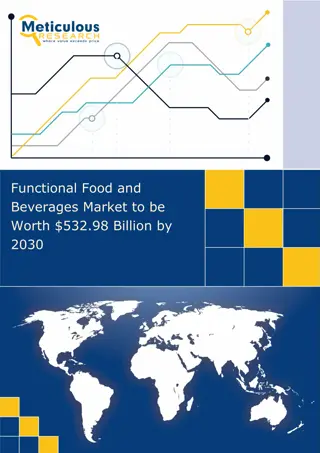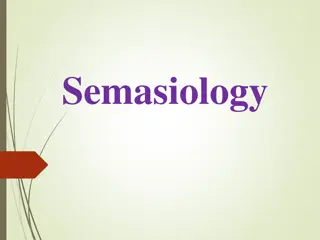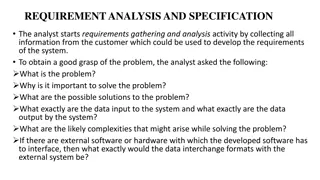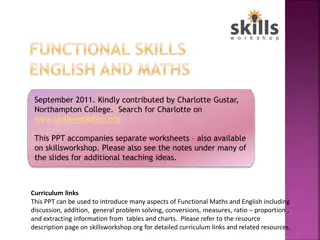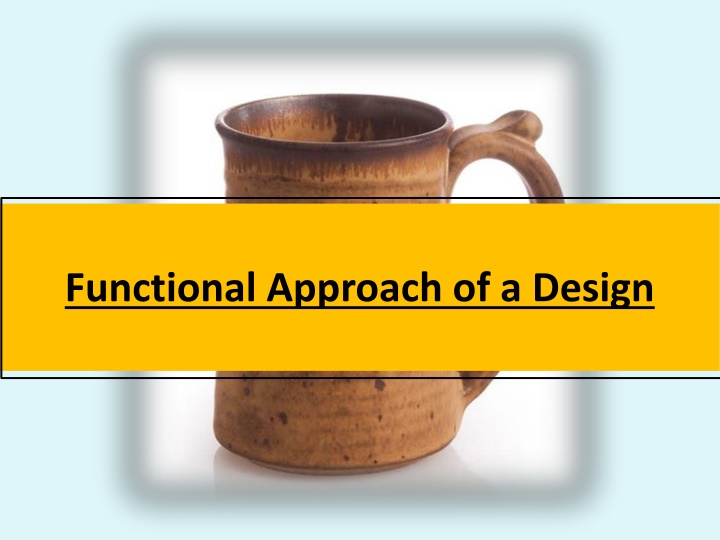
Functional Approach in Ceramics Design: Balancing Aesthetic and Functionality
Discover how ceramic designers combine aesthetic and functional attributes to create products that are both attractive and purposeful. Explore the ways in which productive thinking influences ceramic design, emphasizing the importance of purpose and category classification. Learn about the significance of functional pottery in everyday life and its role in enhancing user experience. Unleash your creativity in hand building with clay to craft functional forms like teapots, mugs, plates, and bowls.
Download Presentation

Please find below an Image/Link to download the presentation.
The content on the website is provided AS IS for your information and personal use only. It may not be sold, licensed, or shared on other websites without obtaining consent from the author. If you encounter any issues during the download, it is possible that the publisher has removed the file from their server.
You are allowed to download the files provided on this website for personal or commercial use, subject to the condition that they are used lawfully. All files are the property of their respective owners.
The content on the website is provided AS IS for your information and personal use only. It may not be sold, licensed, or shared on other websites without obtaining consent from the author.
E N D
Presentation Transcript
Ceramics Designers Ways of Thinking: For designers, strategizing and problem-solving involves finding a balance of aesthetic and functional attributes, using both imaginativethoughts and rationalthoughts . Imaginative thought involves an artistic type of creating, whereby the designer follows his self-motivation to achieve an aesthetic purpose. On the other hand, ceramic designers are also responsible for ensuring their work is functional, solving design problems and making them relevant to real world consumer markets. modern ceramics For example: George Watson s ceramic toaster (Figure 1) combines aesthetic and functional factors, creating a product that is attractive to consumers, both useful and beautifully designed . Watson notes that the toaster is designed to engage the user, re-invigorating the social context of toasting by questioning everything about what we toast with today .
Productive Thinking: For ceramicists, researchers found this notion very workable, as designers must consciously direct their thought processes towards a particular specified end . At the Royal College of Art, Anna Osborne and Victoria Rothschild investigated ceramic and concrete tiles; their final designs suggest a concentration on certain limitations, such as the contrast between glossy ceramic and gritty cement, and the softness and whiteness of glass against the darkness of concrete . Finally, their results were easy to classify in purpose and category.
Functional approach: The mean s of functional having a special activity, purpose, or task.. That means all those products which are used in the routing of human life, we called them functional. Hear we are talking about functional ceramics work. Functional pottery occupies the routine of human. We generally use ceramics products in during food, decoration or some time necessary.
Functional pottery : Any ceramics piece that is not purely decorative and has an intended use. (examples include, but are not limited to: teapots, plates, bowls, mugs, and vases.) Link: https://youtu.be/zXKW0GgXDwE https://youtu.be/_UDLbRqU0PM Functional pottery is made for people to use and many potters feel that the pot isn t complete until it is physically used for its job. But the meaning of function in relation to handmade pottery goes well beyond mere utilitarianism. It should be efficient, easy to use, comfortable in the hands, and give pleasure to the user at the same time.
Design: The creation of a plan or convention for the construction of an object; the look of an object. Functional Approach : Hand building with clay offers endless opportunities for creating a variety of ware and forms. You will be introduced to the basic techniques of pinching, coiling and slab process to enable you to create various functional forms. For examples : Teapots, Mugs, Pen-stand, Plates and Bowls etc. During coming sessions you will be explore and experiment with your materials. You will be more creative and brainstorming with new way of creating ,understanding and developing to achieve your ideas.
These ceramic teapot, bowl, tray and mug lesson plan is a good exercise before proceeding to the practical work in department. These articles is an exercise in designing a three-dimensional structure as well as studying function, proportion, and surface an opportunity for students to think about teapot mechanics, while allowing you to experiment with design elements. Some references to achieve your design: 1. Tea pot: Link: https://youtu.be/OQI71Iea-5U https://youtu.be/C3pU39FJBBc ceramic lesson plan - how to make a teapot - parts of the teapot
2. Bowl: Link: https://www.youtube.com/watch?v=0bKRJ8-gMr0 3.Coffee mug : Link: https://youtu.be/vWz6JJ9dIdk
4. Serving tray : Link: https://youtu.be/ow-l3SyKds4
Assignment Dear students, Your assignment is to prepare two design of each articles that is (Tea pot, bowl, coffee mug and Serving tray ) total 8 design on paper with pen ,pencil or colours as per your convenience. 1. Drawing should be functional form. 2. It will include balance, proportion and shape. 3. It reflects your planning and form mechanics. 4. Your drawing should reflect your hand building skill and techniques and craftsmanship. Some references are also given in this PPT. After finishing your drawing , take pictures and add this assignment with your previous PPT.
Thanks. Madan Singh www.madanceramics.com References: Book: Ceramics (A beginner's guide to tool and techniques), Google and Own thinking



